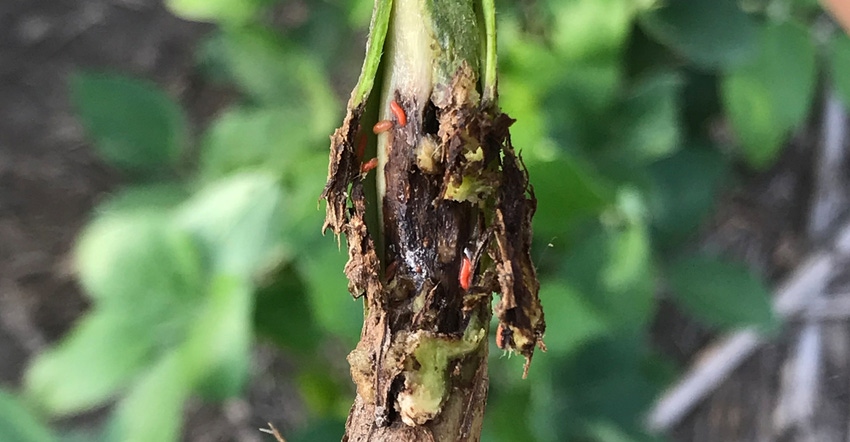
Soybean gall midge has been identified in Nebraska fields as far back as 2011, but it hasn't always been considered a major pest.
"Prior to 2018, this insect was a minor issue and annoyance for growers," says Justin McMechan, Nebraska Extension cropping systems and crop protection specialist. "It would show up in a field that had injury — historically, it had a hail event or disease or something, and you'd find it late in the season. All the way back to 2011, there was really no reason to study it. And then in 2018, it swept 60-some-odd [counties] and killed plants early in the season."
Early in the 2018 season, growers began finding dead soybean plants, and orange larvae feeding on and killing off tissue inside the stem. As of 2019, the gall midge had been identified in 92 counties, including in Nebraska, Missouri, Iowa, Minnesota and South Dakota. Since 2018, however, McMechan and his colleagues have ramped up research on soybean gall midge.
In 2018, researchers in Nebraska captured the first adult soybean gall midge, allowing them to confirm it as a new species of gall midge, Resseliella maxima Gagne.
In 2019, University of Nebraska-Lincoln researchers used cage traps at 27 sites in four states to learn about the gall midge's emergence patterns.
"It wasn't until June that this midge began emerging and at very low levels, but it came from last year's soybean fields," McMechan says. "If you have a soybean field that has had issues this past year, gall midge is going to come from there in 2020."
Depending on the site, adult midges emerged for a 10- to 23-day period. And, including the overwintering generation from the previous year, three generations can emerge in a single season. Because of the insect's long and overlapping emergence, and because larvae feed on the inside of the plant and the adults don't feed on plant tissue, it's difficult to control with insecticide.
However, McMechan encourages growers to look at these findings with some skepticism — these cage traps have a small footprint covering about a 1-by-2-foot area, and with one year's worth of data, that may not paint the most accurate picture of the midge's emergence.
In 2019, he also used time-lapse cameras to monitor plant development and how it affects the gall midge's infestation and emergence patterns. And it appears the midges begin infesting plants at the base of the stem around the V2 or V3 stage.
"As you get further into the vegetative stage, you'll start to see these little expansion points [on the stem] where things spread apart, and there are these little cracks forming," McMechan says. "It appears from time lapse that soybean gall midge is using that to lay eggs into those natural openings that are occurring as a result of stem expansion."
Recent Nebraska research suggests possible alternative hosts for the gall midge. In 2019, UNL doctor of plant health student Amy Hauver surveyed hosts surrounding fields where adults were captured in cage traps. And after submitting samples to colleagues who conducted DNA analyses of the insects on these plants, she identified sweet clover and alfalfa as hosts — although these plants weren't being killed by the gall midge.
"They're probably just background populations, but if you're in an area where soybean gall midge is not hitting soybean fields and you're not seeing injury, you might want to look at those hosts," McMechan says. "[Growers] will find black spots on those hosts. They'll find them much higher on the plant, in some cases up to 2 feet off the ground."
In 2019, Robert Koch, University of Minnesota associate professor and Extension entomologist, identified a separate, similar-looking species, Karshomyia caulicola, or white mold gall midge. This midge, which is not harmful to soybeans, feeds solely on white mold. However, McMechan says its appearance may cause problems with misidentification.
In addition, researchers in Minnesota and Nebraska have identified a possible parasitoid that feeds on the gall midge — and while it was identified in Minnesota and not Nebraska, it may serve as a biological control method.
DNA extractions on soybean gall midge larvae led to the identification of a possible parasitoid. While the species cannot yet be narrowed down, McMechan notes UNL researchers found an equal match to two different species. Robert Koch and Bruce Potter, University of Minnesota Extension entomologists, will be looking into this more in 2020.
"It should be exciting for everybody to know there might be something out there that's feeding on soybean gall midge," McMechan says. "Those samples will go back to Minnesota, and we have some excellent scientists in Minnesota that will dissect the soybean gall midge larvae and see if they can find those parasitoids inside."
Of course, moving forward, the overall goal is determining options for control.
"Adult emergence was a big topic for us; it is the underlying thing that we use for all of our management studies," McMechan says. "We need to know we have activity and how long we have it. But there are lots of questions about larval movement and the timing of when an insecticide is made and planting date. A lot is happening really, really quickly, which is good, but we also need to pay attention to the quality of those studies so we answer some questions and generate new ones."
About the Author(s)
You May Also Like






